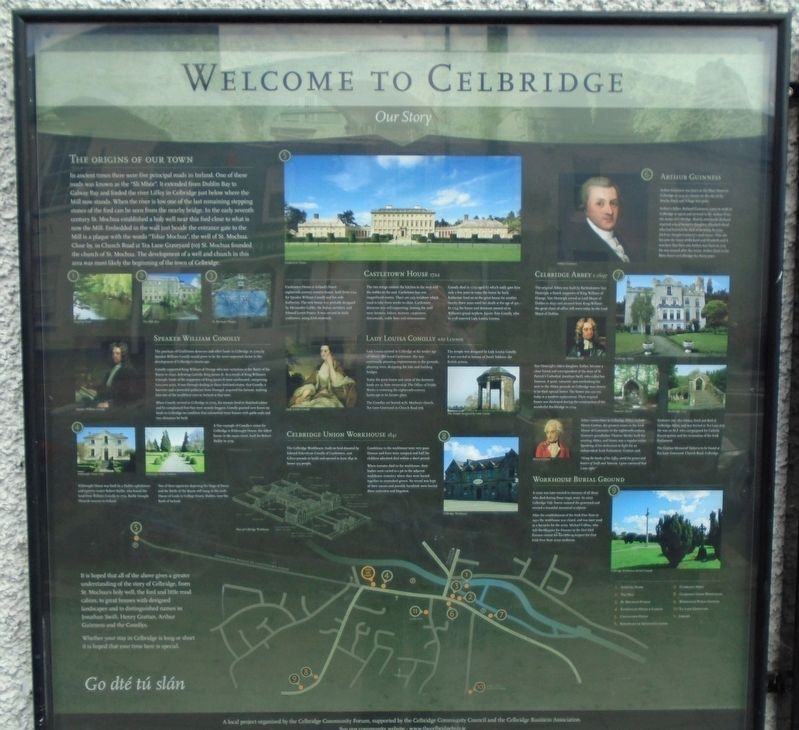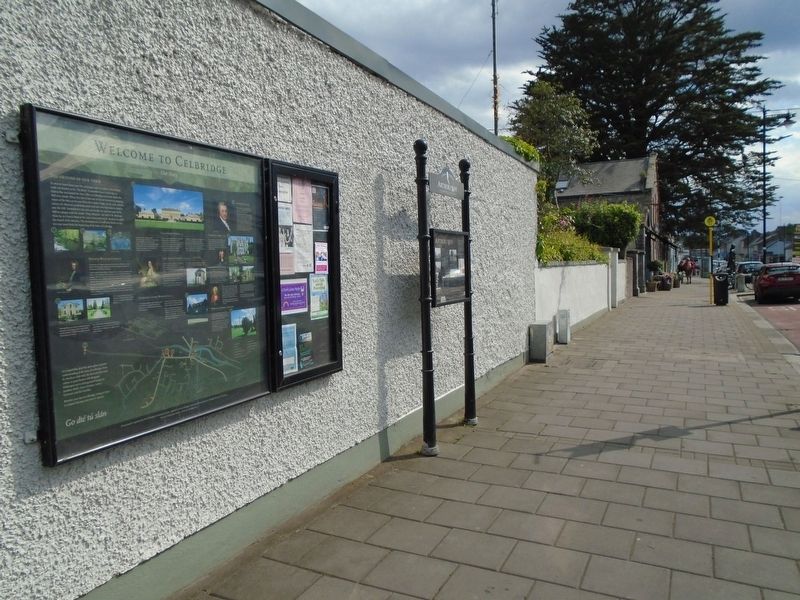Celbridge in County Kildare, Leinster, Ireland — Mid-East (and Dublin)
Welcome to Celbridge
Our Story
In ancient times there were five principal roads in Ireland. One of these roads was known as the "Slí Mhór". It extended from Dublin Bay to Galway Bay and forded the river Liffey in Celbridge just below where the Mill now stands. When the river is low one of the last remaining stepping stones of the ford can be seen from the nearby bridge. In the early seventh century St. Mochua established a holy well near this ford close to what is now the Mill. Embedded in the wall just beside the entrance gate to the Mill is a plaque with the words "Tobar Mochua", the well of St. Mochua. Close by, in Church Road at Tea Lane Graveyard (10) St. Mochua founded the church of St. Mochua. The development of a well and church in this area was most likely the beginning of the town of Celbridge.
[Numbered photo captions read]
1 Stepping Stone
2 The Mill 1850
3 St. Mochua's Plaque
Speaker William Conolly
The purchase of Castletown demense and other lands in Celbridge in 1709 by Speaker William Conolly would prove to be the most important factor in the development of Celbridge's streetscape.
Conolly supported King William of Orange who was victorious at the Battle of the Boyne in 1690, defeating Catholic King James II. As a result of King William's triumph, lands of the supporters of King James II were confiscated, comprising 620,000 acres. It was through dealing in these forfeited estates, that Conolly, a barrister and a powerful politician from Donegal, acquired his fortune, making him one of the wealthiest men in Ireland at that time.
When Conolly arrived in Celbridge in 1709, his tenants lived in thatched cabins and he complained that they were mainly beggars. Conolly granted new leases on lands in Celbridge on condition that substantial stone houses with gable ends and two chimneys be built.
A fine example of Conolly's vision for Celbridge is Kidrought House, the oldest house in the main street, built for Robert Baillie in 1719.
[Numbered photo captions read]
4 Speaker William Conolly
Kildrought House 1719
Kildrought House Gardens
Kildrought House was built by a Dublin upholsterer and tapestry maker Robert Baillie, who leased the land from William Conolly in 1719. Baillie brought Flemish weavers to Ireland.
Two of their tapestries depicting the Siege of Derry and the Battle of the Boyne still hang in the Irish House of Lords in College Green, Dublin, now the Bank of Ireland.
Castletown House 1722
Castletown House is Ireland's finest eighteenth-century country house, built from 1722 for Speaker William Conolly and his wife Katherine. The new house was probably designed by Alessandro Galilei, the Italian architect, and Edward Lovett Pearce. It was erected by Irish craftsmen, using Irish materials.
The two wings contain the kitchen to the west and the stables to the east. Castletown has 100 magnificent rooms. There are 229 windows which used to take three weeks to clean. Castletown demesne was self-supporting. Among the staff were brewers, bakers, weavers, carpenters, dairymaids, stable boys and stonemasons.
Conolly died in 1729 aged 67 which sadly gave him only a few years to enjoy the house he built. Katherine lived on in the great house for another twenty three years until her death at the age of 90. In 1754 the house and demesne passed on to William's grand nephew, Squire Tom Conolly, who in 1758 married Lady Louisa Lennox.
[Numbered photo caption reads]
5 Castletown House
Lady Louisa Conolly née Lennox
Lady Louisa arrived in Celbridge at the tender age of fifteen. She loved Castletown. She was continually planning improvements to the grounds, planting trees, designing the lake and building bridges.
Today the great house and some of the demesne lands are in State ownership. The Office of Public Works is restoring the eighteenth-century landscape to its former glory.
The Conollys are buried at St. Mochua's church, Tea Lane Graveyard in Church Road (10).
The temple was designed by Lady Louisa Conolly. It was erected in honour of Sarah Siddons, the British actress.
[Photo captions read]
Lady Louisa Conolly
The Temple designed by Lady Louisa
Arthur Guinness
Arthur Guinness was born in the Main Street in Celbridge in 1725 at a house on the site of the Mucky Duck and Village Inn pubs.
Arthur's father, Richard Guinness, came to work in Celbridge as agent and steward to Dr. Arthur Price, the rector of Celbridge. Shortly afterwards Richard married a local farmer's daughter, Elisabeth Read, who had learned the skill of brewing. In 1722, Dr. Price bought Carberry's malt house. This site became the home of Richard and Elisabeth and it was here that their son Arthur was born in 1725. He was named after the rector. Arthur lived in the Main Street in Celbridge for thirty years.
[Numbered photo caption reads]
6 Arthur Guinness
Celbridge Abbey c.1697
The original Abbey was built by Bartholomew Van Homrigh, a Dutch supporter of King William of Orange. Van Homrigh served as Lord Mayor of Dublin in 1697 and secured from King William the great chain of office still worn today by the Lord Mayor of Dublin.
Van Homrigh's eldest daughter, Esther, became a close friend and correspondent of the dean of St Patrick's Cathedral, Jonathan Swift, who called her Vanessa. A quiet, romantic spot overlooked the weir in the Abbey grounds in Celbridge was chosen to be their special bower. The bower you can see today is a modern replacement. Their original bower was destroyed during the construction of the wonderful Rockbridge in 1724.
Other connections to Celbridge Abbey include Henry Grattan, the greatest orator in the Irish House of Commons in the eighteenth-century. Grattan's grandfather Thomas Marley built the existing Abbey, and Henry was a regular visitor. Speaking of his dedication to fight for an independent Irish Parliament, Grattan said:
"Along the banks of the Liffey, amid the groves and bowers of Swift and Vanessa. I grew convinced that I was right."
Grattan's son, also Henry, lived and died at Celbridge Abbey and was buried in Tea Lane (10). He was an M.P. who campaigned for Catholic Emancipation and the restoration of the Irish Parliament.
The Grattan Memorial Tablet is to be found at Tea Lane Graveyard, Church Road, Celbridge.
[Numbered photo captions read]
7 Jonathan Swift
Celbridge Abbey
Vanessa's Bower
Rockbridge 1724
Henry Grattan
Celbridge Union Workhouse 1841
The Celbridge Workhouse, built on land donated by Edward Pakenham Conolly of Castletown, cost 6,800 pounds to build and opened in June 1841 to house 519 people.
Conditions in the workhouse were very poor. Disease and fever were rampant and half the children admitted died within a short period.
When inmates died in the workhouse, their bodies were carted to a pit in the adjacent workhouse cemetery where they were buried together in unmarked graves. No record was kept of their names and possibly hundreds were buried there unknown and forgotten.
[Numbered photo captions read]
8 Plan of Celbridge Workhouse
Celbridge Workhouse
Workhouse Burial Ground
A cross was later erected in memory of all those who died during those tragic years. In 2007 Celbridge Tidy Towns restored the graveyard and erected a beautiful memorial sculpture.
After the establishment of the Irish Free State in 1922 the workhouse was closed, and was later used as a barracks for the army. Michael Collins, who was the Minister for Finance in the first Dáil Éireann visited the barracks to inspect the first Irish Free State army uniforms.
[Numbered photo caption read]
9 Celbridge Workhouse Burial Ground
It is hoped that all of the above gives a greater understanding of the story of Celbridge, from St. Mochua's holy well, the ford and little mud cabins, to great houses with designed landscapes and to distinguished names in Jonathan Swift, Henry Grattan, Arthur Guinness and the Conollys.
Whether your stay in Celbridge is long or short it is hoped that your time here is special.
Go dté tú slán
Erected by Celbridge Community Forum, Celbridge Community Council, and Celbridge Business Association.
Topics. This historical marker is listed in these topic lists: Architecture • Colonial Era • Settlements & Settlers. A significant historical year for this entry is 1709.
Location. 53° 20.444′ N, 6° 32.248′ W. Marker is in Celbridge, Leinster, in County Kildare. Marker is on Main Street (Leinster Route R405) close to Maynooth Road (Leinster Route R405), on the left when traveling south. Touch for map. Marker is in this post office area: Celbridge, Leinster W23 C2N4, Ireland. Touch for directions.
Other nearby markers. At least 8 other markers are within walking distance of this marker. Arthur's Way / Cosán Arthur (here, next to this marker); Kildrought House (within shouting distance of this marker); Sir Gerald Dease, K.C.V.O. (about 150 meters away, measured in a direct line); Edward Bridgeman (about 150 meters away); St Patrick's Church, Celbridge (about 150 meters away); Celbridge Union Workhouse Cemetery Gate (approx. half a kilometer away); Celbridge Abbey (approx. half a kilometer away); Celbridge Union Workhouse Cemetery (approx. half a kilometer away). Touch for a list and map of all markers in Celbridge.
Also see . . . Celbridge at Wikipedia. (Submitted on December 14, 2019, by William Fischer, Jr. of Scranton, Pennsylvania.)
Credits. This page was last revised on January 1, 2024. It was originally submitted on December 14, 2019, by William Fischer, Jr. of Scranton, Pennsylvania. This page has been viewed 285 times since then and 40 times this year. Photos: 1, 2. submitted on December 14, 2019, by William Fischer, Jr. of Scranton, Pennsylvania.

